By TREVOR HOGG
Images courtesy of Fin Design + Effects and Netflix.
By TREVOR HOGG
Images courtesy of Fin Design + Effects and Netflix.
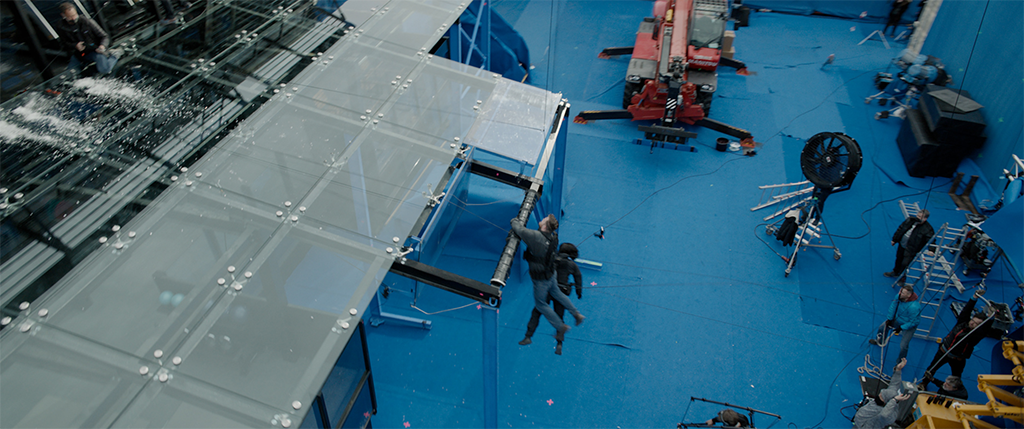
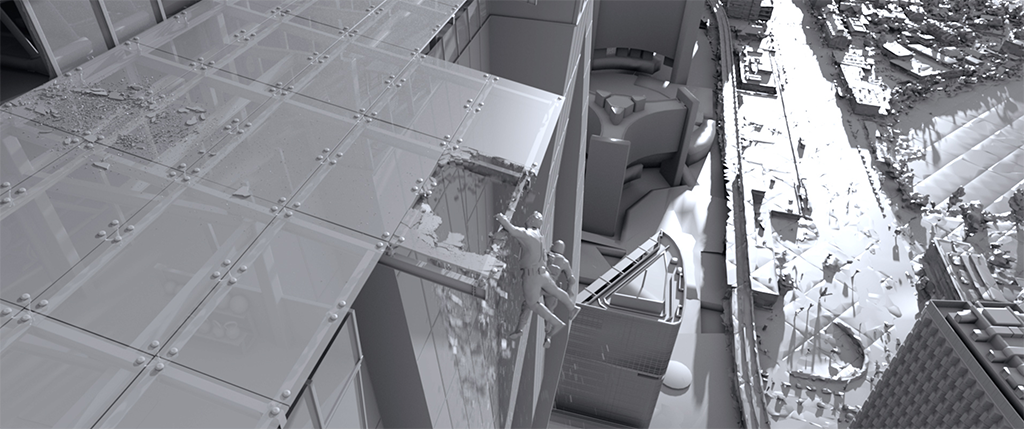

A major environment build for Fin Design + Effects was constructing Vienna with moving traffic.
Thought to be dead mercenary, Tyler Rake (Chris Hemsworth) returns in the Netflix sequel Extraction 2 where the action shifts from Bangladesh to Austria under the direction of Sam Hargrave. Further complications arise when attempting to rescue a crime lord’s family from a Georgian prison. Contributing to the mayhem is Visual Effects Supervisor Björn Mayer and an army of vendors. One of the contributors was Fin Design + Effects, which over a period of six months produced 150 shots that consisted of a 360-degree panoramic view of Vienna and the climatic glass-awning fight scene.
“The thing that prepared me the most was watching the first one, and you get a sense that it’s going to be a gritty action movie [like] John Wick, but much more in your face,” states Will Towle, Visual Effects Supervisor at Fin Design + Effects. “There are different types of visual effects movies. You have Guardians of the Galaxy, which are your bombastic huge-effects shows. Then you’ve got your more down-to-earth invisible effects stuff like Extraction 2, which fits well in my compositing background. The challenge for this kind of movie is that you have to get the audience to buy into it and see the peril that the characters are in. Compositing is all about those finishing touches and adding believability. I’m also a believer that wherever possible we should use live-action effects. You can’t get more real than real. Quite often you can use them in combination with CG to bring the CG up to the next level.”
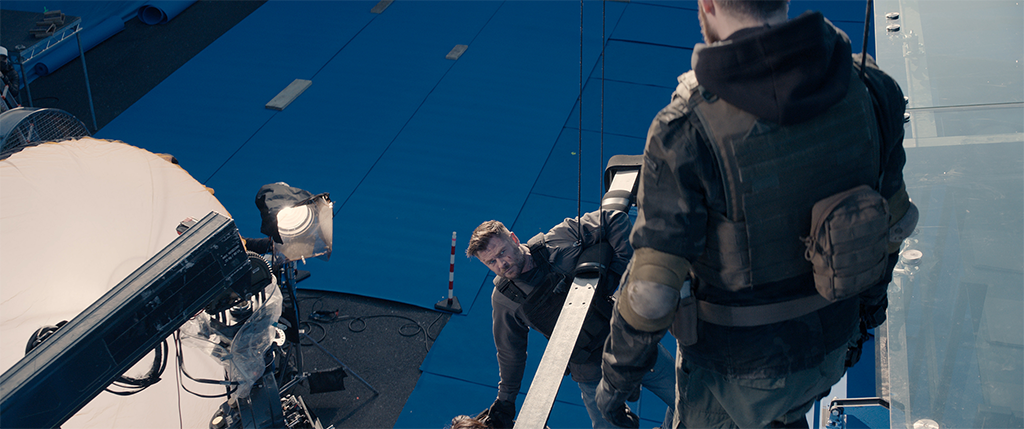

Despite building a large set piece for the awning fight sequence, major set extensions were required to replace the bluescreen.
Clear and concise instructions were articulated by Mayer. “Björn knows what he wants, and they had actually built quite a big set of the awning, but we ended up replacing all of it because you have reflections in the pieces of glass such as crew members and bluescreen,” Towle remarks. “It gave us a good starting point and base to ground our CG. Early on, Björn and I talked about other references. Pictures were shared of what this sequence might look like. We started with broad strokes and we slowly zoomed into the tiny details like anisotropic filtering, dirt maps on the glass, and kept adding layers of detail to the CG build until it looked photoreal.” Rotomation of the characters was a critical part of the process. “Because we were replacing the glass in every shot and glass is highly reflective, that required us to do accurate digital doubles of four or five characters, and those had to be rotomated into every single shot,” Towle explains. “This is not work we’ve done too extensively before, so new pipeline tools had to be written to help with that, and new animation tools as well.”
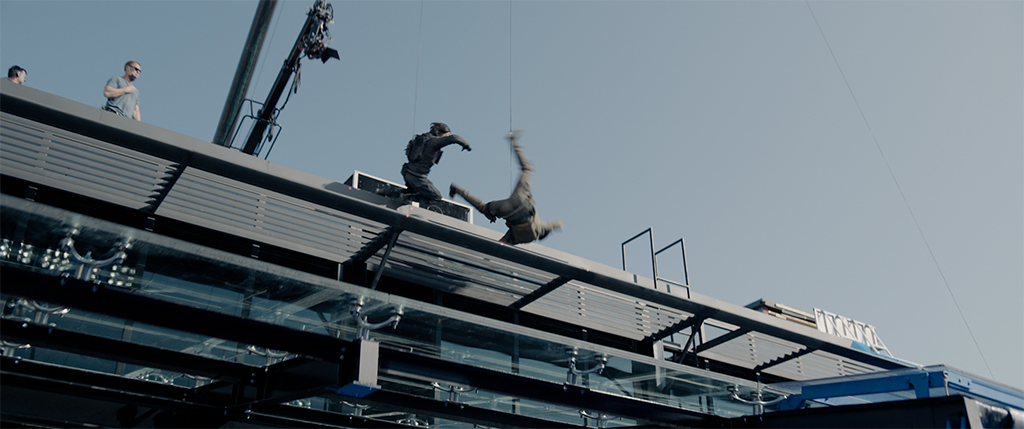
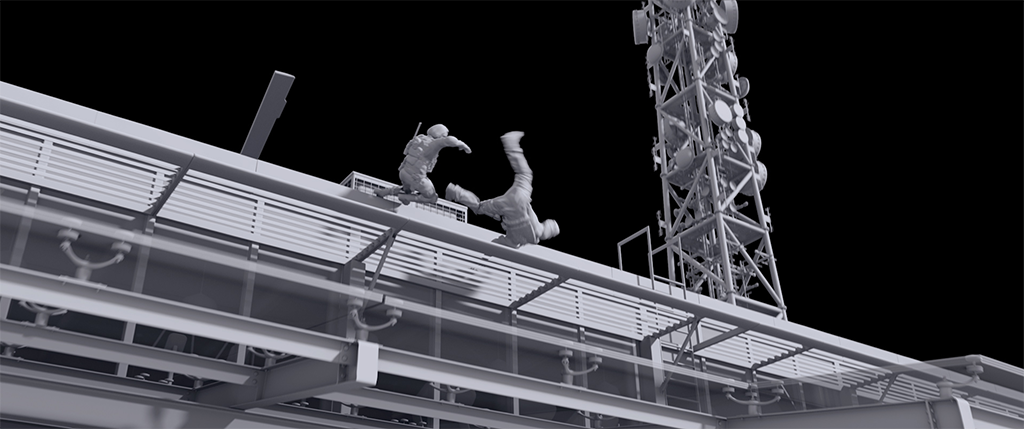

Everything had a basis in plate photography, which helped to provide a ground truth for the CG.
Guiding the shot design process were storyboards and previs. “We can start placing our cameras and see what pieces of the build might need to be up-res’d because there is a level of detail scale where the further from camera it is, the fewer details we put in to save render time and disk space,” Towle explains. “Björn and his team had flown a helicopter over Vienna and taken thousands of photos from all different positions, which was fantastic for getting a sense of the environment and what the sun looks like at the time of day that the sequence is taking place. Vienna’s midday sun is bright with not much atmosphere. We also did a lot of research on Google Maps. We flew cameras over the area on Google Earth and did some photogrammetry to build a proxy city early on to figure out camera angles and what buildings we would see from what camera height.”
“The challenge for this kind of movie is that you have to get the audience to buy into it and see the peril that the characters are in. Compositing is all about those finishing touches and adding believability. I’m also a believer that wherever possible we should use live-action effects. You can’t get more real than real. Quite often you can use them in combination with CG to bring the CG up to the next level.”
—Will Towle, Visual Effects Supervisor, Fin Design + Effects
Half of the 150 shots were entirely digital. “I would love to keep as much plate as I can, but, unfortunately, for a lot of these shots we did have to replace them with CG,” Towle states. “The challenge there was making it look as much like the reference as possible. It helped us in a way to go full CG. In almost every shot the characters are still plate, and for this show, to assist us keep the sequence on track in terms of color and lighting, we created a neutral grading pipeline for Fin Design + Effects; this is the first time we’ve done that. What that entailed was neutral grading every single shot in the sequence, and that allowed us to create our Vienna city in a neutral graded environment as well. It enabled us to light, render and drop a shot in that is looking good already and you’re nudging the last five percent in compositing. But we still had live-action elements, and with those come rebuilding edges, roto and bluescreen removal.”
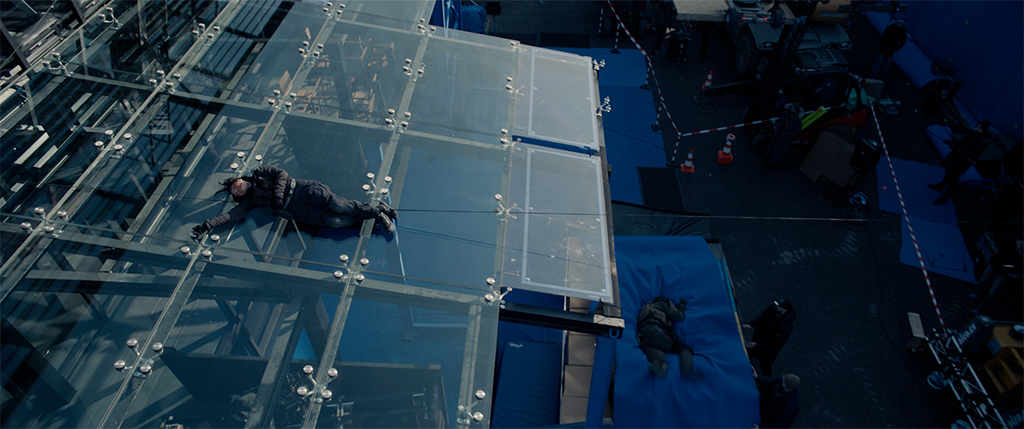

The hardest part of the glass-awning fight sequence was replacing the reflections and refractions of the crew and bluescreen.
Constructing the DC Towers and surrounding Vienna were the biggest photoreal environments for Finn Design + Effects. “How are we going to build the city and add moving traffic to it?” Towle observes. “We had to have moving reflections on every surface and nearby buildings as well. That was something we were definitely anticipating. Also, the way that light travels through glass and compositing glass has some fundamental difficulties. Glass is all reflections and refractions; that’s classically quite difficult to comp because if you have a CG render of a pane of glass and you’re seeing through it, you don’t have a depth channel for the stuff you’re seeing through it. You have a depth channel of the piece of glass. We had to come up with a way to defocus all of this stuff properly. To effectively achieve that in compositing we came up with a method to stripe out the reflections and refractions from the pieces of glass, defocus them separately using a different depth channel and recombine them all. That was all done in comp.”
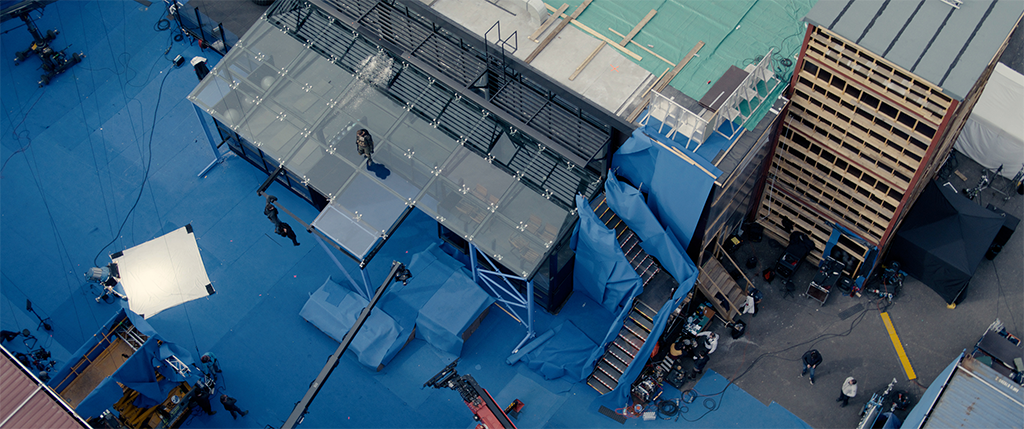
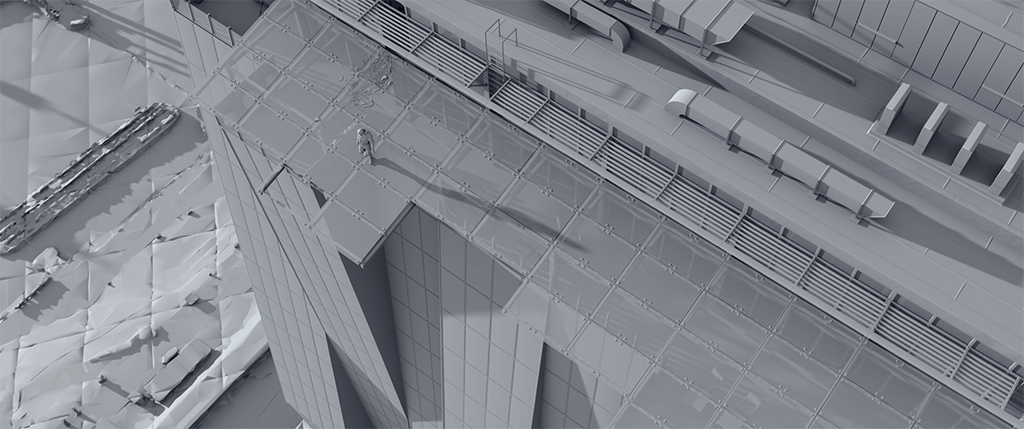

Deep compositing was critical in being able to manipulate and produce the correct reflections and refractions in the glass.
“[T]hey had actually built quite a big set of the awning, but we ended up replacing all of it because you have reflections in the pieces of glass such as crew members and bluescreen. It gave us a good starting point and base to ground our CG. Early on, Björn [Visual Effects Supervisor Björn Mayer] and I talked about other references. Pictures were shared of what this sequence might look like. We started with broad strokes and we slowly zoomed into the tiny details like anisotropic filtering, dirt maps on the glass, and kept adding layers of detail to the CG build until it looked photoreal.”
—Will Towle, Visual Effects Supervisor, Fin Design + Effects
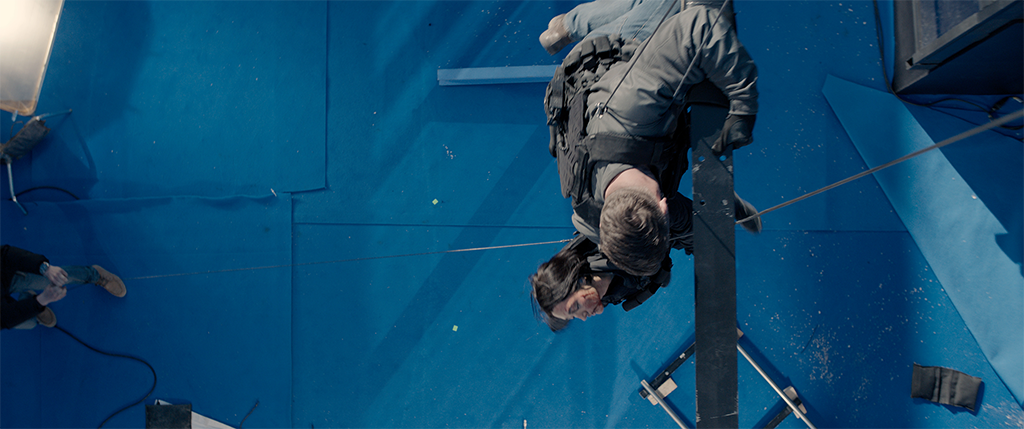
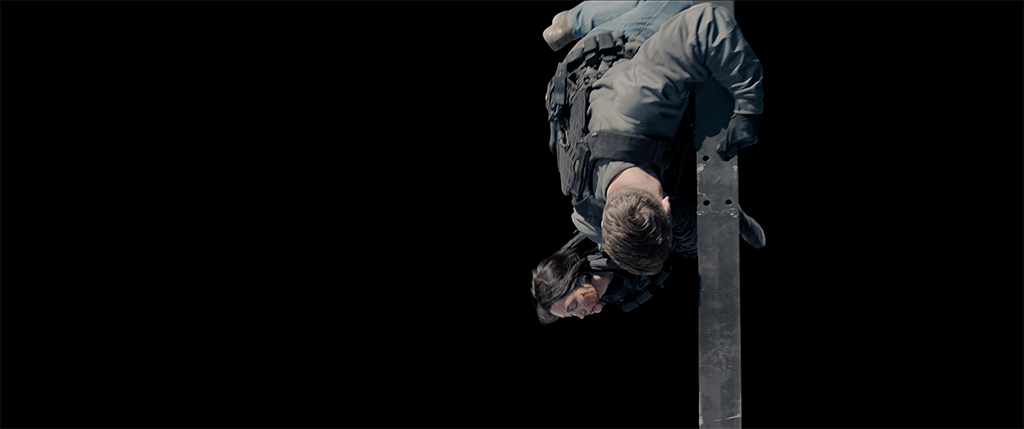

Rotomation was utilized extensively for the characters and their digital doubles.
“For the hero shots that were close to the glass,” Towle continues, “we rendered it in two different layers and comped it back together in deep compositing so we didn’t have to render with holdouts. We could push and pull layers every so slightly using deep compositing. Then, just as we expected, the build of the city was extremely challenging. We started with a photographic base that was our ground truth, then put it on a sphere to see how it looks. You begin to notice things that are not in the correct perspective, like warped buildings. You can go, ‘That building needs to be reprojected onto geometry, while this one has to be full CG.’ We used it as a guide for how detailed our environment had to be. The furthest-away stuff was on a sphere. As you got a bit closer, it was put on cards, even closer on geometry, and the closest full CG. That allowed us to keep our render times down and still get a believable photoreal result.”
Watch Fin Design + Effects’ amazing behind-the-scenes work on the glass-awning fight sequence in their Extraction 2 VFX Breakdown. Click here: https://www.findesign.com.au/projects/extraction-2/